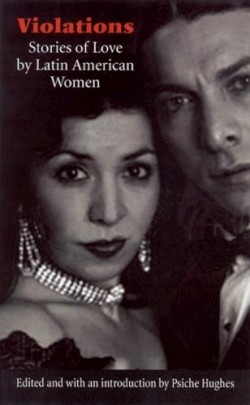Violations
Stories of Love by Latin American Women
In a time when society is preoccupied with the obscenities of war, this book insists on love as a centrifugal force. The editor takes readers on a tour of Latin America, into the cities, small towns, nunneries, and gardens from Cuba to Mexico, from Peru to Brazil, where summer is winter, and the mystical lore of religious beliefs are pure truth, and there is room for extremes to bathe one another in sweat and tumble in strewn bed sheets until one is indistinguishable from the other.
Hughes translates with tremendous grace. Each piece retains a distinct, powerful voice, treating readers to a chorus of accomplished Latin American authors, living in Havana, Mexico City, Baranquilla, Buenos Aires, Rio de Janeiro, Arequipa, born in Montevideo, exiled to Spain. Each writer displays a mastery of storytelling and the beauty of the written word. The authors and their characters are fiercely in touch with their emotions and their sexuality. They share language, religion, and culture, yet the stories’ themes are universal, and not all the fictional narrators are females.
The characters are deftly drawn and embody a range of personalities, from the lonely mistress in love with her maid in Elena Poniatowska’s “Love Story,” to the woman obsessed with a man who resembles Michelangelo’s David in Marilyn Bobbe’s “In Florence Ten Years Later,” to the obese flower-tender in Andrea Blanque’s “Immensely Eunice,” to the wild housewife with the disobedient husband in Liliana Heker’s “Spick and Span.” That love can endure, regardless of culture’s jealousy and fear of passion, is portrayed in beautiful language to an emotionally stirring end in “Procession of Love” by Nelida Pinon.
The stories are erotic, but the prose remains elegant, tasteful, and sophisticated. In the first story, by Peri Rossi, “To Love or To Ingest,” a man waits to feast on his lover’s flesh. Food and her body are delightfully difficult to distinguish: “hard-shelled crustaceans, rosy shellfish, lustful oysters” and, for solid food, “buttocks flambées à l’orange.”
In addition to their concupiscence, the stories provide fascinating historical contexts, as in Sylvia Lago’s “Golden Days of the Queen of Diamonds,” in which a professional hymen-mender fixes a bride-to-be, and Luisa Valenzuela’s “Impossible Story,” in which Montezuma lives again. And not all are serious: in “Young Amatista,” Alicia Steimberg whimsically illustrates the innocent sexuality of prepubescent girls in petticoats, dreaming of angels masturbating harps.
The collection is brave, takes risks. In Armonia Somer’s “The Fall,” a statue of the Virgin turns to flesh and beds down with a wanted murderer. Fanny Buitrago’s “The Sea From the Window” describes, in gorgeous prose, blemishes, deformations, and sufferers of rare illness. “Jerico understands how to caress a fevered brow, to comfort the mass of beating flesh, of a body anguished by ineffable earthly nostalgia, to sing to sleep the macrocephalic Siamese twins.” In this story, men’s hearts are dove’s eggs and women are thin as needles.
Ultimately, in this collection, women reign supreme, skillfully using societal roles rather than abiding them. They are puissant, admirable, and smart, like the self-possessed, humorous narrator of Margo Glantz’s “English Love,” the supposedly betrayed wife in Angeles Mastretta’s “Aunt Mariana,” the passionate, cunning liar in Ana Maria Shua’s “Farewell my Love,” and the likable murderess in “Santa Catalina, Arequipa” by Teresa Ruiz Rosas. Even as they are clever, these characters are also compassionate, like the aging prostitute in Luis Valenzeuala’s “End of the Millennium.”
Hughes lectures at London University and at City Literary College. She is the coauthor of the definitive Dictionary of Borges and the translator of works by Cristina Peri Rossi and Carmen Boullosa. Readers familiar with Latin America will find that the collection does exhibit, as Hughes suggests in her introduction, a metamorphosis of women’s role in the culture, which tends to violate love by imposing strictures upon it. At the same time, the collection retains the beauty of a culture in which food is described in luxurious lick-lipping detail, bougainvillea overflow onto two story garden walls, women travel to buy fine cheeses, and ancient nunneries still stand with their vestibules for devotional torture.
Religion is influential throughout the book and tangles with the erotic. In this fiery and very contemporary collection, which asks how married Eros is to Bacchus and how connected the flame of rapture is to the fierce blue fire of hate, God appears on the side of sensuality and creates new commandments deeming it a sacrilege not to enjoy the genitalia. And celestial angels arrive with bunches of grapes, rubbing them against the phallus of the Almighty.
Reviewed by
Suzanne Kingsbury
Disclosure: This article is not an endorsement, but a review. The publisher of this book provided free copies of the book to have their book reviewed by a professional reviewer. No fee was paid by the publisher for this review. Foreword Reviews only recommends books that we love. Foreword Magazine, Inc. is disclosing this in accordance with the Federal Trade Commission’s 16 CFR, Part 255.

